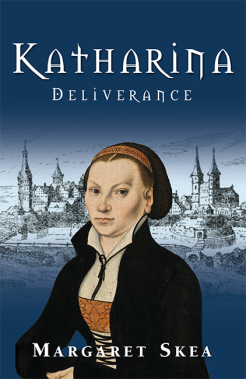Katharina, the narrator of this historical novel, is remarkably ordinary. She isn’t stunningly beautiful, or spectacularly insightful. Her faith isn’t the strongest, nor are her decisions always right. And yet she also (spoiler alert!), married one of the most prominent men of the Reformation Era – Martin Luther himself. How?
As the author herself admits, little factual detail is known about Katharina von Bora, but the events of her life provide a remarkable frame for this fictional tapestry to hang on. It is well known that Katharina was an escaped nun, but I certainly didn’t know that she was part of the first group of nuns to leave a convent due to Luther’s religious teachings, and that it was illegal for her to do so. Indeed, where this book excels is in evoking the religious-political climate in which Katharina lived, from the convents she grew up in to Wittenburg and its bustling culture. Through her eyes, we enter into the difficulties faced by faithful Christians when Luther published his 95 theses and split the Catholic church into divided, angry and fearful factions.
We see the challenges Katharina and her fellow former nuns faced in re-integrating into society, from families, friends, and romantic prospects who shunned them to the inability to financially support themselves. As they settle into the community of Luther’s supporters based in Wittenburg, we share their concerns for the state of the early Reformation, as key figures come and go, develop alternative teachings and even start riots and uprisings. Luther’s position was not as secure as we often now believe, and his zeal and frustration are evocatively sketched. Many of the chapters even begin with a relevant quote from Luther’s own writings, a touch of finesse I found particularly engaging. And even within the narrative, it is to the author’s credit that the religious controversies are not dumbed down or skimmed over, but are rather an integral part of the developing plot. Indeed, Katharina’s own faith develops as a result of these events, not apart from them.
For all that the reader knows that Luther and Katharina will end up married, the wider events are even more compelling than their journey towards matrimony. Indeed, the proposal and marriage, which are the climax of the book, feel more like a realistic reflection of the union between two such characters than a Hollywood romantic ending.
‘Katharina: Deliverance’ is due to be followed sometime in 2019 by a sequel, ‘Katharina: Fortitude’, and if I have one criticism of the novel, it is related to this. Throughout the novel, a framing device is used from a scene much later in Katharina’s life – a point in the timeline which ‘Deliverance’ doesn’t reach. Personally, I found this somewhat frustrating, but it didn’t seriously impact my enjoyment of the main story. Overall, this book achieves the remarkable feat of being an enjoyable read, an historical insight and a challenge and encouragement to the believer’s faith. It isn’t fact, but it is admirably well-written and faithful fiction. I am glad to recommend it.
This book is available to purchase from all good bookshops, including Waterstones.
Miriam Montgomery, Free Church Books

